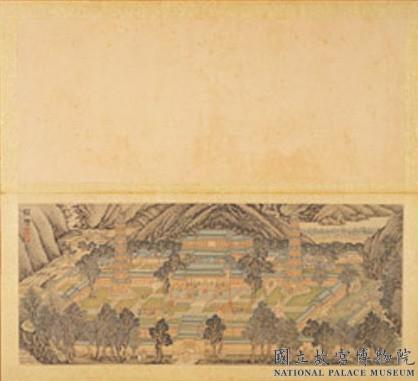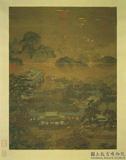明吳彬歲華紀勝圖 冊 浴佛
推薦分享
資源連結
連結到原始資料 (您即將開啟新視窗離開本站)後設資料
- 資料識別:
- 故畫001285N000000004
- 資料類型:
- 類型:繪畫
- 型式:靜態圖像
- 著作者:
- 吳彬
- 主題與關鍵字:
- 夏景 山徑 溪澗、湍泉 行旅 百姓 僧(和尚、尼姑) 松 柏 房舍 寺廟 塔 水利 籬笆、圍牆 宗教器用
- 出版者:
- 數位化執行單位:國立故宮博物院
- 格式:
- 本幅 29.4x69.8公分、全幅 70.3x76.8公分
- 關聯:
- 石渠寶笈續編(乾清宮),第一冊,頁433&*故宮書畫錄(卷六),第四冊,頁63&* 吳彬,活動於明萬曆十九年(一五九一)至崇禎十六年間(一六四三),福建莆田人,流寓南京,後以善畫,被召為中書舍人,深獲神宗賞賜。曾遠遊西蜀,目睹劍門、峨嵋、岷山諸大山川之雄奇。中晚期以後山水畫多以誇張和變形的手法,強調山巒峻削雄偉之感。 本冊共十二幅,描繪各月份的節慶活動。本次選展二幅:「結夏」以界畫樓閣庭院,曲橋荷塘,作斜向構圖,人物畫法一致,但各具情態。「浴佛」畫寺廟依山傍水而築,與自然環境融揉一片。兩幅描繪俱精緻而饒古趣。 &*Selections from A Record of Yearly Observances: The End of Summer and Bathing the Buddha Wu Pin (fl. 1591-1643) Ming Dynasty Exhibited here are two of the twelve leaves of the album A Record of Yearly Observances, which depicts the festivals of each month of the year. These two carefully executed outline-paintings, The End of Summer and Bathing the Buddha, have a slightly archaic air. Wu Pin was a native of P’u-t’ien, Fukien, but spent most of his life in Chin-ling (modern Nanking). His artistic talents brought him a position in the Secretariat, and his works were much admired by the emperor Shen-tsung (r. 1573-1620). Wu Pin traveled to western Szechwan, where he visited the unusual scenery of Mount Omei, Sword-pass Mountain, and Mount Min. His later landscapes, equally unusual, depict awesomely precipitous mountain ranges modeled in an exaggerated, somewhat surrealistic style. &* 吳彬,萬曆間(西元一五七三至一六一九年)以書畫聞名於世。福建莆田人,流寓金陵(今南京)。字文仲,所繪佛像人物,形狀奇特,不同於前人,自成一家。山水畫布置亦極新奇而不摹古。 本幅為「歲華紀勝圖冊」之第四開,畫四月景。四月八日為佛誕。據聞釋迦牟尼出生時,諸天群集,以香水敬沐世尊,故佛誕又稱浴佛節。本作採俯瞰式構圖,院中僧侶群集,參禮佛像。寺塔重重,井然有序。瓦瓴、屋脊、石階等皆用界,線條簡潔有力,建築結構清晰可辨。 &*Buddha-washing Festival Wu Pin (active 1573-1619) Ming dynasty Wu Pin, excelling in calligraphy and painting, was a native of P’u-t’ien, Fukien, but settled in Nanking. His style name was Wen-chung. He painted Buddhist images and figures in an unusual style, completely different from his predecessors. His landscape compositions were also different from the ordinary. He eschewed copying ancient manners. The fourth leaf of the album “Scenes of the Twelve Months”, this painting represents a scene of the fourth lunar month. The eighth day of the fourth lunar month was the birthday of the historical Buddha Śākyamuni. It is said that after the Buddha was born, celestial beings gathered and washed the Buddha with fragrant water. As a result, the birthday of Śākyamuni is also called the Buddha-washing Festival. The leaf depicts a scene from high above in which many monks assemble in a Buddhist monastery in order to pay homage to a Buddha statue. Layers of buildings are well organized. Roof tiles, ridges of roofs, and stone steps are all drawn with a ruler. Ruled lines are simple and forceful. The structures of the buildings are portrayed in a clear manner. &*故宮書畫圖錄,第二十三冊,頁70-75
- 管理權:
- 國立故宮博物院
授權聯絡窗口
- 國立故宮博物院圖像授權、出版授權、影音資料授權-申請流程說明
http://www.npm.gov.tw/zh-TW/Article.aspx?sNo=03003061






